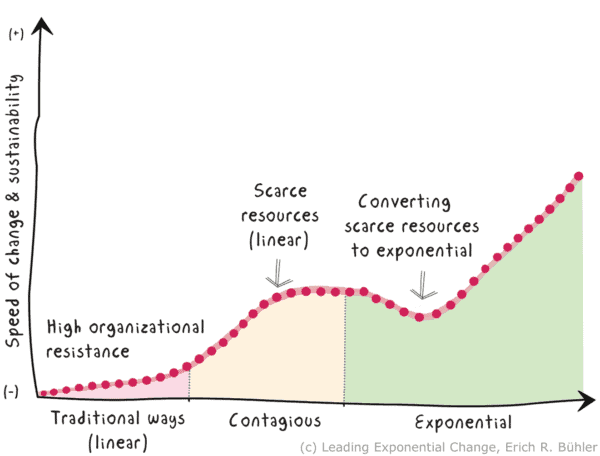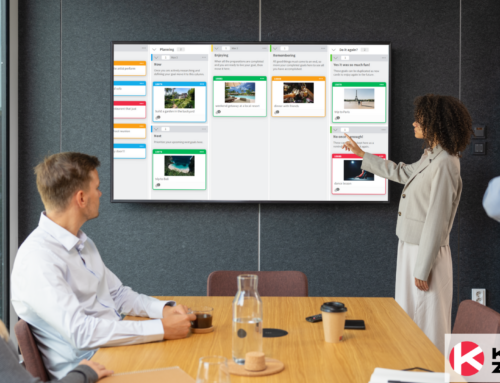
When leaders ask me “Will Kanban or the Scrum framework work here?“, the most important thing I want to address is the leader’s implicit premise that the framework will be getting better outcomes than in other competing companies. There is also something that needs to be considered here… Is this going to be sustainable? There is more to improving processes than just implementing new processes, and this is where mental agility can come in handy.
Organizational Health
When I say this, I mainly want to make sure they understand that whatever is done or suggested should not deteriorate organizational health.
From my perspective, Organizational health is Psychological safety—how people feel about talking freely and making decisions in the company—plus the creation of sustainable business value in perpetuity.
“ORGANIZATIONAL HEALTH: Psychological safety plus the creation of sustainable business value in perpetuity.”
Here, the word perpetuity is crucial as it represents a behavior or practice that needs to be maintained over time. It doesn’t mean that you have to use these words in your organization but, at least, the values and ideas behind it should be considered somehow.
For example, making people work long hours to meet a deadline or not having enough quality in something you build—if it is not done in a controlled and premeditated way—could make you get quick results but will not be sustainable. This obviously burns out people in the medium term.
These two concepts are key if you want to deal with continuous change and adaptation, and these two questions need to be addressed even long before thinking of implementing a new way of working.
In my experience, when a non-experienced Leader thinks of Agile or wanted to add new ways of working or doing things, it generally means in their mind that the same practices and processes across all circumstances, departments, and people will be established and normalized. This is a very interesting mindset because it can be used as an example of how they think of change and its culture works.
For example, if you are working with a large company that has been operating under the assumption that they have a great product and that customers will always buy it, then they might also assume that the framework will work well as a result of standardizing everything they do. This is an extension of the factory mindset toward the way of doing things.
If the leader is working instead with a small group of people in the organization, then their thinking may be different than that. And this is because she would be able to see that it’s not about the framework and processes itself but how individuals increase their mental agility and embrace new values to solve the day-to-day challenges.
A must-have skill is to understand how people try to solve a challenge, and how they can temporarily embrace different points of views and values.
Reframing
This is what we call in Neuroscience of change, Reframing. Reframing is a powerful set of cognitive techniques that allow us to analyze a problem from different perspectives, guiding people to temporarily think as the person with the problem or from the perspectives of those who observe the problem, or even the individuals who don’t believe there is a problem. This makes it possible to reach different conclusions and evaluate different assumptions.
Reframing is also important if you are going through a difficult situation as it helps regulate emotions and diminish conflict.
From the brain’s perspective, it encourages new neural connections and results in innovative ways of thinking that help the company evolve. The crucial thing here is not about how the person sees the problem from another perspective, but how he or she can embrace temporary external values and principles that might be opposite to theirs.
The more “frames” a person can produce during a situation, the more flexible she or he will become. I believe that any company where their employees don’t have adequate levels of mental agility would struggle to build sustainable innovation and would be less resilient.
Mental Agility
As you can see, competitive advantage is not just about frameworks but about initially helping individuals to get high levels of mental agility. That is why when I published my book, Leading Exponential Change, I created a model for Enterprise Coaches that places Mental Agility at the foundation of the company.
In my perspective, any organization that wants to have high levels of resilience and be able to produce innovation should have greater levels of mental agility.
Also, when the speed of change defies comprehension, conflict increases if the right practices, procedures, and techniques are not in place. So it is important to understand how mental Agility connects with the concepts of Exponential Change and Linear change.
Companies exposed to markets that are constantly changing require certain ingredients so that the desired behaviors become exponential—that is, for people to offer low resistance to change and be open to new ideas, with positive and proactive attitudes toward learning.
Employees should also be willing to modify how they think when they come across information that contradicts their beliefs or reasoning.

Figure 1: Ways to make a change and corresponding sustainability, (c) Leading Exponential Change, Erich R. Bühler.
Allow me to clarify the difference between exponential and contagious. In a company where change is contagious, nearby departments—uninvolved in the change—observe the change and adopt or copy some of their ideas or processes. If they find something interesting or useful, they will add it to their own toolbox as a new skill. But keep in mind that contagious mechanisms become very complex if you try using them to expand a practice, technique, or framework throughout the rest of the company.
In a business transformation where change is exponential, the result is different. Here, members of departments that surround those who are changing will feel that their own ways are outdated. They will fervently want to copy, understand, take over, and evolve the new processes. They feel it’s no longer possible to maintain the status quo, that their world has changed, and that a door has opened leading to a better individual and group life within the organization.
To achieve this, the focus must be placed on increasing the mental agility of all the minds of the organization—and not just some departments in the company. People must be able to achieve a state of continuous well-being despite constant change.
Many firms begin by improving and making their software processes more adaptable (technical agility). This makes it possible to build a company more flexible and responsive to market disruptions. But while it might sound like a good initial strategy, it’s not enough to increase the adaptability of the entire company (enterprise agility).
Enterprise Agility
To accelerate change, I developed a long time ago a change framework based on the Neuroscience of change that allows organizations to adapt faster and that is used by change consultants around the world. It is based on five dimensions of Agility:
1. Technical agility — Changing software as quickly, cheaply, and securely as possible.
2. Structural agility — Changing the organization’s structures and procedures by running experiments while minimizing the impact on organizational health.
3. Outcomes agility — Delivering results even during turbulent times to respond to changing market conditions. This is related to leadership, budgeting, and how people and the company can change strategy and continue to produce great results with minimal impact on organizational health.
4. Social agility — Connecting well with other employees or with customers in rapidly changing environments, thereby achieving highly collective performance.
5. Mental agility — Reframing challenges to find new solutions even during stressful times. If the brain cannot accept emerging situations and realities or be able to reframe them using a high number of frames (mental agility), then employees will rarely adapt to new market conditions.

Figure 2: The five types of Agility in Enterprise Agility. (c) Leading Exponential Change, Erich R. Bühler
When the context changes, people must be able to find simpler and more innovative habits (or micro-habits) that allow them to better connect with each other, with customers, and with strategic partners (social agility). The company must be able to experiment and deliver results, even in times of high turbulence (outcomes agility).
The key here is what I call a Powerful change Plan. Any plan that wants to influence change and accelerate adoption over time should include these five different concepts. That means that the cake should be cut “vertically”, and obviously you can’t just “eat’ the chocolate at the top when designing a change strategy.
This model is crucial to building an extremely resilient organization that is able to create innovation and adapt faster in perpetuity to disruptive market conditions.
I still remember, a bank with remarkably good agile teams (I.T.) I helped in New Zealand a long time ago was looking to expand the agile mindset and practices to the rest of the firm. They started building multi-functional groups all across the organization but somehow didn’t work as expected.
Some employees previously worked on their own (financial and risk evaluation folks) or with individuals with similar mindsets and they didn’t like the idea of working in new ways.
You need to consider that the human capacity to adapt to new ways of working depends largely on their personality, environment, and the type of profession they have been doing for years.
As you can imagine, placing the focus on the framework or in standard agile practices would not work well in that bank. The key to this challenge was to increase the mental agility of the employees and to make sure that they have good working agreements that promote healthy behaviors in perpetuity.
So when we think about influencing change in a company like this, you should consider how well people are at experiencing a high number of different frames (mental agility) when facing problems or new situations.
In my opinion, the more reactive you are without the capacity to reframe problems, the worse your chances of success will be.
Additionally, fear can reduce the number of frames the brain evaluates. For example, when a person feels that she’ll lose prestige, power, or even her position in the company, that will activate an area of the brain called the amygdala. The amygdala is located in the center of your brain, which is where you store all your memories and information. It’s involved in the formation of new neural connections between neurons. This process is called synaptic transmission. The amygdala controls our emotions, thoughts and it’s aggressively triggered when you are under stress, fear, or situations where you might lose prestige or power.
It basically disconnects your high reasoning centers by flooding your head with certain hormones and prepares you for a fight or flight response. When this happens, your brain is on alert mode, and you are not able to produce the same number of “frames”.
Powerful change plans based on five levels of agility and understanding Mental Agility and exponential change are crucial concepts if you want to influence change. Furthermore, all this happens even before you consider embracing a new framework or new ways of working.
I hope now when Leaders ask you “Will Kanban or the Scrum framework work here?”, you have now a new toolset to help the organization be a better place.
This was a guest blog. Please review our guest blog disclaimer.
Learn to Work Smarter, Not Harder!
Get our top articles weekly.
Table Of Contents
Discover many more posts…







